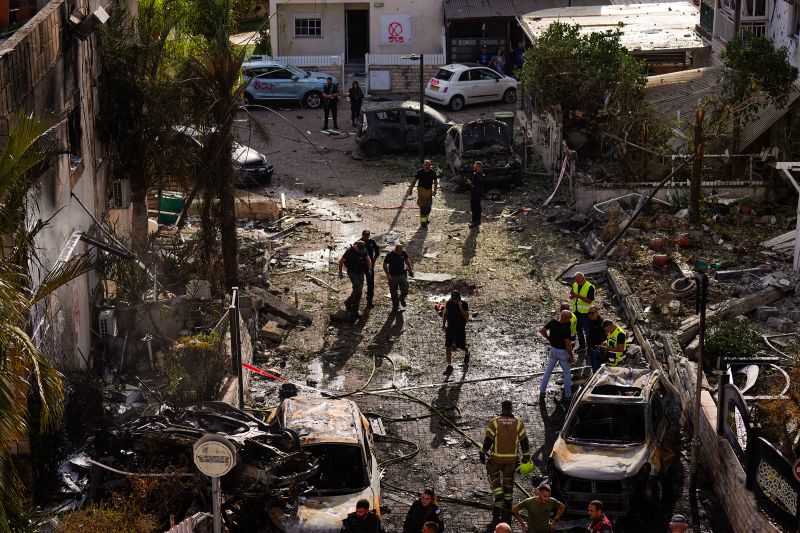Hezbollah is believed to be the most heavily armed non-state group in the world. Backed by Iran and based in the eastern Mediterranean country of Lebanon, the Shiite Islamist group has been engaged in confrontations with Israeli forces on Lebanon’s southern border since October 8.
Hezbollah first fired at Israel to protest the war in Gaza, demanding a ceasefire there as a condition to end its attacks. Cross-border hostilities have since escalated, culminating in the death of Hezbollah’s leader, Hassan Nasrallah, in an Israeli strike on the Lebanese capital Beirut.
The cross-border conflict and recent developments have raised the specter of a regional conflagration and amplified intense diplomatic efforts to de-escalate tensions. Though no match for Israel’s military might, Hezbollah’s increasingly sophisticated arsenal has the potential to inflict significant damage on Israel.
Israel would also have to contend with Hezbollah’s strategic depth. The group is part of an Iran-led axis of militants spanning Yemen, Syria, Gaza and Iraq. Some of these groups have increased coordination significantly since October, when Israel launched a war in Gaza after Hamas-led militants attacked the country. This axis is known in Israel as the “ring of fire.”
For nearly a year, Hezbollah’s partners in the region have been engaged in a simmering conflict with Israel and its allies. Yemen’s Houthis have sporadically fired at vessels in the Red Sea, an artery of global trade, as well as on Israel. Islamic Resistance in Iraq, an umbrella group of hardline Shiite factions, has also launched attacks on US positions in that country. The axis has conditioned the cessation of those hostilities on a ceasefire in Gaza, rebranding themselves as a “supportive front” for Palestinians in Gaza, as described by a senior Hezbollah leader.
In September, Israel stepped up its direct confrontation with Hezbollah. In back-to-back attacks, hundreds of Hezbollah’s pagers and walkie-talkies exploded, killing at least 37 people and injuring thousands, before an Israeli airstrike on Beirut killed a senior Hezbollah commander. In response, Hezbollah has vowed “a battle without limits.”
Following the twin communications attacks, Hezbollah launched what it said was a ballistic missile at Israel, targeting the headquarters of Israel’s intelligence service Mossad. It is believed to be the first ballistic missile to be launched by militant group toward Israel. The strike, which was intercepted, reached near the bustling city of Tel Aviv.
Hezbollah’s fighting force emerged from the rubble of Israel’s 1982 invasion of Beirut. At the time, it was a rag-tag group of Islamist fighters supported by Iran’s fledgling Islamic Republic. This was followed by a meteoric rise in the group’s military and political might. In 2000, its guerrilla fighters forced Israeli forces to withdraw from south Lebanon, ending a more-than-20-year occupation. In 2006, it survived a 34-day war with Israel that wreaked havoc on Lebanon.
During Syria’s uprising-turned-civil war in the 2010s, it fought on behalf of Syrian President Bashar al-Assad as he brutally quashed armed opposition forces and inflicted a huge civilian death toll. As it fought in the trenches of that nearly decade-long war, Hezbollah became seasoned in urban warfare and solidified its alliances with other Iran-backed groups fighting in Syria. It also cleared a vital supply route for weapons between Iran and Lebanon, via its partners in Iraq and Syria, further bolstering its arsenal.
Hezbollah’s military capabilities have notably grown since its last war with Israel in 2006. Military analysts estimate Hezbollah to have between 30,000 and 50,000 troops, but earlier this year its leader Nasrallah claimed it has more than 100,000 fighters and reservists. The group is also believed to possess between 120,000 and 200,000 rockets and missiles.
Experts say the group’s biggest military asset is the long-range ballistic missile, of which it is estimated to have thousands, including 1,500 precision missiles with ranges of 250–300 kilometers (155–186 miles).
Throughout its decades-long conflict with Israel, Hezbollah has been engaged in asymmetric warfare. It has sought to grow its political and military might, while seeking to establish deterrence despite Israel’s military superiority.
But Hezbollah threads the needle carefully. Provoking Israel’s full firepower could significantly degrade the group’s capabilities, setting it back years – if not decades – and destroying large parts of Lebanon, which has buckled under the weight of its years-long financial crisis.
As the confrontations at the border continue, Hezbollah has sought, with some success, to undermine Israel’s vaunted missile defense system known as the Iron Dome. It has tried to do so by attacking its platforms and overwhelming it with swarms of drones and short-range missiles in order to open a path for other projectiles to reach deeper into Israeli territory.
The full extent of Hezbollah’s arsenal is not clear. In response to Israel’s twin wireless device attacks, Hezbollah fired a barrage of missiles across the border into northern Israel, and said it hit an air base with Fadi 1 and Fadi 2 missiles – a longer-range weapon not known to have been used so far in nearly a year of conflict.
Hezbollah’s chances of survival in an all-out war with Israel is hinged on whether or not it can outsmart these systems which have in recent months intercepted thousands of airborne weapons from Iran, Gaza and Lebanon.
Because of Hezbollah’s growing power, a possible all-out war between Israel and Lebanon would thrust the Middle East into uncharted waters. The diplomatic effort to prevent it is likely to continue at a breathless pace.
